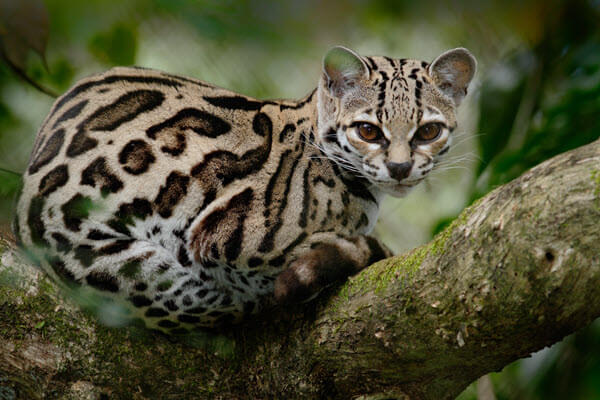The margay is a Central and South American small wild cat that looks like an ocelot. You may also hear it referred to as the “tree ocelot” because of its appearance (it looks like an ocelot) and climbing ability.
Scientific name: Leopardus wiedii
Conservation status: Near Threatened
Subspecies: There are 3 currently recognized subspecies:
- L. w. wiedii – lives south of the Brazilian state Amazonas
- L. w. vigens – lives north of Amazonas
- L. w. glauculus – lives in Central America
Interesting margay facts
- Looks like an ocelot
- Spends most of its life in trees
- A highly skilled and able climber
- Like the clouded leopard and possibly the marbled cat, it can climb headfirst down trees
- Can jump up to 12 feet horizontally
- Can hang from a branch with one foot
Physical characteristics
The margay has brown fur with rows of black or dark brown spots and streaks. The cat’s ears are black with a round white mark in the middle. The underbelly of the margay is a lighter off-white color. The margay’s tail has dark bands around it with a black tip.
Weight: 5.7 – 8.8 lbs.
Body length: 19 -31 inches
Tail Length: 13 – 20 inches
Habitat (where the margay lives)
The margay inhabits numerous states in Mexico, especially where there are tropical lowlands. You can
also find the Margay throughout Central America, and down as far as Brazil and Paraguay. The cat also inhabits Uruguay and northern Argentina. According to fossil remains dating back to the Pleistocene era, the margay once lived in the state of Texas in the U.S.A, as well as Florida and Georgia.
Hunting and prey (diet)
The margay is primarily a nocturnal cat. It is a skilled and agile climber with the ability to grab branches with its paws. Most of its life is spent in the trees, where it preys on birds and monkeys. The cat also eats lizards, tree frogs, small mammals, grass, fruit and vegetation.
Reproduction and lifespan
Gestation lasts about 80 days, resulting in the birth of a single kitten. The kitten is usually born between March and June. Margays have lives more than 20 years in captivity. How long they live in the wild is unknown.
Conservation threats
The illegal hunting of margays until the 1990s resulted in a significant decline in their population. Other threats include loss of habitat due to deforestation.

